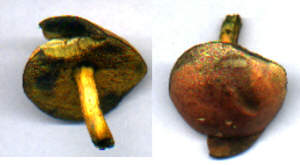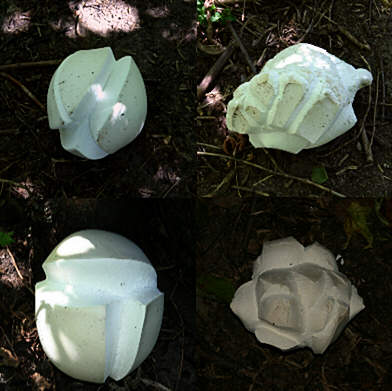Fungus
Jack Schmidling Productions, Inc.
18016 Church Road ~ Marengo IL 60152
Phone:815 923 0031 ~ Email:jack@schmidling.com
MOST RECENT PHOTOS PHOTO INDEX HOME PAGE
New SLIDE SHOW New

Witch's Butter
Tremella mesenterica
I don't know where Witch's Butter comes from but I like to think of this jelly fungus as Winter's Flower.
Although it can be found year round in most of North America, it is most exciting to find it on a Winter walk after a thaw of a few days.
It is most commonly found on Oak trees and is considered edible.

ASH TREE BOLETE
This is one of the most flavorful mushrooms we can find around here. It pops up sporadically between June and October and we generally can pick them 3 or 4 times during the season. As the name implies, they are symbiotic with ash trees but also maples, both of which are in abundance around here. We find them in the lawn, and in the woods, particularly after a good rain.
Our favorite way of eating them is fried in butter with scrambled eggs. They also make a great soup.

Unlike more common mushrooms, boletes do not have "gills" under the cap. The spores are produced in tightly packed tubes that look sort of like a sponge from the bottom.
An interesting characteristic of this bolete is that shortly after cutting or breaking, the flesh turns blue.
Much to our surprise on our morning walk today (Aug 29), we found one of our favorite Fall mushrooms popping out of trees all over our property. The Box Elder mushroom usually does not appear until October around here.
It is more commonly known as the Elm Oyster and it's former Latin name was Pleurotus ulmarius, implying an affinity for elm trees. However, I have never seen one on an elm tree and they are very commonly found on Box Elders so I have taken the liberty of calling it the Box Elder Mushroom. This also avoids the confusion with the oyster mushroom which is another excellent edible.

Box Elder Mushroom
Their typical habit is to grow out of knot holes or injuries in Box Elder trees. This picture shows a not too unusual clump of them growing out a knot hole but more often, there is just one per knot but frequently several in a single tree.
When first appearing, they are just little pea-sized balls which grow to 5-10 inches in about a week. The ones in the picture are from 2 to 3 inches in diameter. They taste very much like the commercial button mushroom but a bit milder. The flavor does not seem to be affected by the size but the larger they get the more likely it is that they will contain bugs so we pick them as soon as we see them.
One of the most incredible growing things to be found in the woods in fall is the Giant Puffball. This is the largest mushroom to be found in North America and this year (2004) was the most prolific in the ten years we have lived out here. There were puffballs everywhere.

GIANT PUFFBALL
Calvatia gigantea
Marilyn is holding the largest one we found and the others in the picture were collected from a small area behind our chicken coop.
Although very tasty, some folks have a bad reaction to puffballs and I happen to be one of them. I get stomach cramps every time I try them so I quit eating them long ago.

So when we called our friend and mushroom lover Carolyn Collins
to come and get them, she sent us this picture.

We declared last year the "Year of the Puffball" because we found so many and such very large ones.
Not sure what to call this year but it certainly is the year of the draught and I attribute the lack of rain to the most unusual shapes of the few puffballs we did find.
This one looks just like a white rose.

This montage is of the four we found in the woods where the sheep play.
The one on the top right looks like a conch shell found on a sandy beach.
While searching for morels in our woods a few weeks ago, my daughter found what appeared to be a soft stone. After a little poking and digging, we came up with a perfectly round ball with a single rootlike stem coming out the bottom. My first thought was a puffball but this was nearly covered with soil and only a small part sticking out. This is not the way puffballs develop.
After browsing our library of fungus books, my wife found a drawing that looked exactly like our "stone" in the stinkhorn section of one of the books. A stink horn is a tall fungus that bursts out of the ground and as the name implies, produces a very unplesant odor as it ripens. The genus of the fungus is Phallus which gives a good idea of what it looks like. The stink attracts flies that move on to spread the spores for future generations.
After browsing our library of fungus books, my wife found a drawing that looked exactly like our "stone" in the stinkhorn section of one of the books. A stink horn is a tall fungus that bursts out of the ground and as the name implies, produces a very unplesant odor as it ripens. The genus of the fungus is Phallus which gives a good idea of what it looks like. The stink attracts flies that move on to spread the spores for future generations.

These two pictures were taken with a web cam a few minutes after collecting another sample. When first dug up, it was just a dirty white but started turing blue by the time I got the camera set up.
The cut open view clearly shows the embryo of the stinkhorn. I was always under the impression that these things developed very rapidly but after about 3 weeks, there still is no sign of any stinkhorns

STINKHORN
Then after one more week, each of the "eggs" hatched into a stinkhorn.
I am not absolutely certain of the species so I am open to corrections.

VEILED STINK HORN
This bit of erotica is known as the Veiled Stinkhorn.
It typically has a black stinky "gleb" over the cap but it was apparently washed off by rain.
For more info and pics....Stinkhorn
